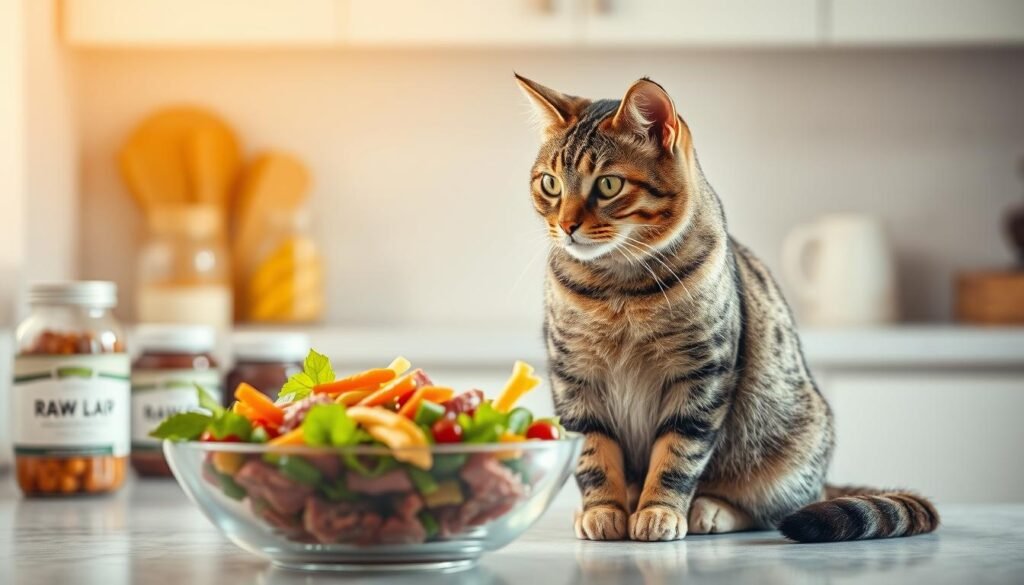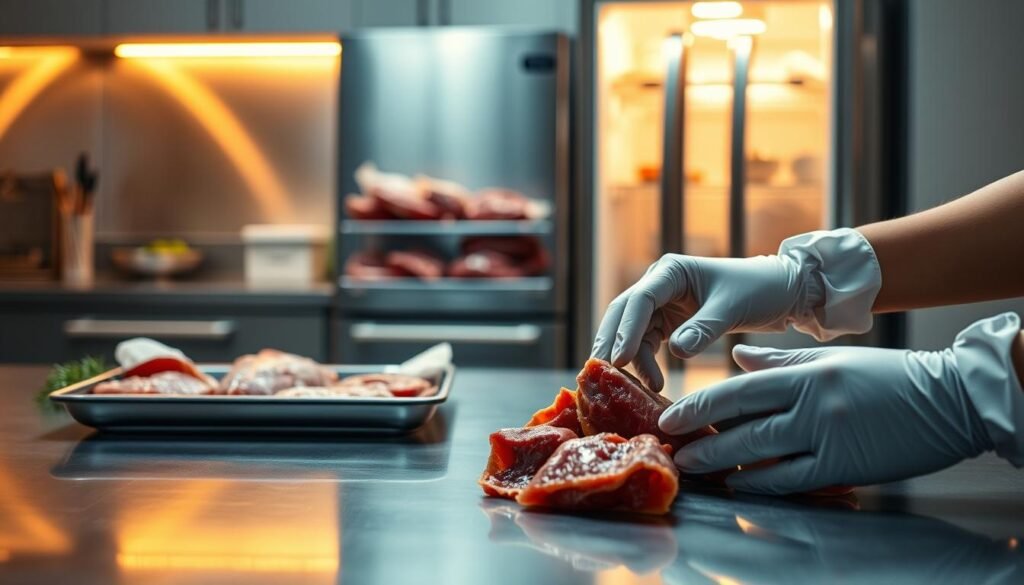Ultimate Guide to Raw Food for Cats: Safe, Healthy & Natural Feeding
Table of Contents
As a cat owner, you want the best for your pet. This includes a diet that matches their natural eating habits. Cats are obligate carnivores, needing a diet rich in animal protein to stay healthy.
Switching to a diet like what they would eat in the wild can greatly improve their health. It boosts their energy and overall well-being. A balanced and nutrient-rich diet is key for their optimal health.
Learning about the benefits and best ways to feed your cat a diet high in animal protein is important. It helps you make better choices for their nutrition. This is the first step to a healthier, happier pet.
What Is a Raw Food Diet for Cats?
The raw food diet for cats is based on their wild ancestors’ eating habits. It involves feeding them uncooked meat, bones, and organs. This diet aims to be as natural as possible for your cat.
The Evolutionary Diet of Felines
Cats need a diet rich in animal protein. Their natural diet includes high protein, moderate fat, and little carbs. In the wild, they eat their prey whole, getting a balanced mix of nutrients.
Modern Raw Feeding Philosophy
The modern raw feeding philosophy stresses variety and balance. It includes different meats, bones, and organs to ensure all nutrients are met. It’s believed that cats do best on a diet that closely mimics their natural diet.
Commercial vs. Homemade Options
Cat owners can choose between commercial raw food and homemade meals. Commercial options are convenient and nutritionally complete. Homemade diets offer customization but require careful planning to be balanced.
Choosing between commercial and homemade diets depends on your cat’s needs, your lifestyle, and your commitment. Whether you pick commercial or homemade, the diet must be balanced and meet your cat’s nutritional needs.
The Benefits of Raw Food for Cats
Feeding your cat raw food has many benefits. It can improve their health and wellbeing.
Improved Digestion and Nutrient Absorption
A raw diet can make your cat’s digestion better. They will have smaller, less smelly stools. This is because raw food is easier to digest than processed foods.
The high-quality protein and fats in raw meat help your cat absorb nutrients better. This means they get the most from their meals.
Healthier Coat, Skin, and Dental Health
Raw food can make your cat’s coat shinier and skin healthier. The nutrients in raw meat promote healthy skin and a vibrant coat.
It also helps keep their teeth healthy. Raw bones help remove tartar and plaque, keeping their teeth clean.
Weight Management and Muscle Development
Raw feeding includes lots of protein. This helps with weight management and muscle development. Cats on a raw diet often stay at a healthy weight and have strong muscles.
This is great for indoor cats or those at risk of obesity.
Reduced Allergies and Sensitivities
Switching to a raw diet can reduce allergies and sensitivities in cats. Raw food avoids common allergens in processed cat foods.
This helps your cat feel more comfortable and lowers the chance of allergic reactions.
Potential Risks and Considerations
Raw feeding has many benefits but also some risks. Cat owners need to know these risks and considerations. A raw diet can be very good for cats, but there are things to watch out for.
Bacterial Contamination Concerns
One big worry with raw feeding is bacterial contamination. Raw meat can have harmful bacteria like Salmonella and E. coli. These can hurt cats and the people who care for them.
Nutritional Imbalance Risks
There’s also a chance of nutritional imbalance. Cats need specific foods, and a raw diet must be balanced right. If not, it can cause health problems.
Cost and Time Investment
Raw feeding can cost more and take up more time than regular kibble. It needs careful handling and storage to keep risks low.
When Raw Feeding May Not Be Appropriate
In some cases, raw feeding isn’t right. This includes cats with health issues or homes with people who are immunocompromised.
| Risk Factor | Description | Mitigation Strategy |
|---|---|---|
| Bacterial Contamination | Risk of Salmonella and E. coli | Proper handling and storage |
| Nutritional Imbalance | Incorrect formulation | Consult a veterinarian or pet nutritionist |
| Cost and Time | Increased expense and effort | Plan meals, buy in bulk |
Essential Nutrients in a Raw Cat Food Diet
Feeding your cat a raw diet is important for their health. Cats are meat-eaters and need a diet rich in animal products.
Protein Requirements for Felines
Cats need a high-protein diet to stay healthy. They do best with protein from animals like chicken, beef, and fish.
Healthy Fats and Fatty Acids
Cats also need healthy fats and fatty acids. These give them energy and keep their skin and coat healthy. Salmon and chicken fat are good sources.
Critical Vitamins and Minerals
Cats need certain vitamins and minerals too. Vitamin A and calcium are key for their health. They help with vision and bone strength.
Taurine and Other Essential Amino Acids
Taurine is an amino acid found in animal tissues. It’s crucial for a cat’s heart and vision. Making sure they get enough taurine is important.
To understand what cats need, let’s look at a summary of key nutrients and their benefits:
| Nutrient | Source | Benefit |
|---|---|---|
| Protein | Chicken, Beef, Fish | Muscle Mass, Overall Health |
| Healthy Fats | Salmon, Chicken Fat | Energy, Skin, and Coat Health |
| Vitamin A | Organ Meats | Vision, Immune Function |
| Calcium | Bones, Dairy | Bone Health |
| Taurine | Animal Tissues | Heart Health, Vision |
Best Commercial Raw Food for Cats
Looking for an easy way to feed your cat raw food? Many commercial options are available. These include frozen, freeze-dried, and dehydrated foods, meeting different needs and tastes.
Frozen Raw Cat Food Brands
Frozen raw cat food is very nutritious. It keeps natural nutrients in raw meat. Choose a frozen raw cat food that is complete and balanced for your cat’s needs.
Complete and Balanced Options
Some top brands for complete and balanced frozen raw cat food are:
- Stella & Chewy’s
- Primal Pet Foods
- Radical Raw
Supplemental Raw Products
Supplemental raw products are great for adding variety to your cat’s diet. They can be mixed into their regular food or given as treats.
Freeze-Dried and Dehydrated Choices
Freeze-dried and dehydrated raw cat foods are convenient and shelf-stable. They are lightweight, easy to store, and can be rehydrated as needed.
Convenience and Shelf-Stable Benefits
Brands like Orijen and Acana provide high-quality freeze-dried and dehydrated raw cat food. These are rich in nutrients and easy to store.
Rehydration Techniques
To rehydrate freeze-dried or dehydrated raw cat food, just add water. The amount of water to add varies, so follow the manufacturer’s instructions.
| Brand | Type | Key Features |
|---|---|---|
| Stella & Chewy’s | Frozen | High-protein, grain-free, and rich in omega-3 fatty acids |
| Orijen | Freeze-Dried | Mimics the cat’s natural diet, rich in fresh meat and fish |
| Primal Pet Foods | Frozen | Offers a range of protein sources, including chicken, beef, and duck |
How to Transition Your Cat to a Raw Diet
A raw diet can greatly benefit your cat. But, it’s important to introduce it slowly to avoid digestive problems. Transitioning your cat to a raw diet needs a careful plan to ensure a smooth change.
Gradual Introduction Methods
Begin by mixing a small amount of raw food with your cat’s current meals. Slowly increase the raw food portion over time. This step-by-step transition helps avoid digestive upset.

Strategies for Picky Eaters
For picky cats, try warming the raw food slightly or adding tasty liquid. As one expert says,
“Cats often prefer their food at room temperature or slightly warmed, as it more closely mimics the temperature of freshly caught prey.”
This small change can make the raw diet more appealing to your cat.
Monitoring Health During Transition
Keep a close eye on your cat’s health during the transition. Look out for signs like diarrhea or vomiting. Adjust the transition pace if needed. Regular health checks and diet adjustments are key for a successful transition.
When to Consult Your Veterinarian
If your cat shows any adverse reactions or you have concerns, consult your vet. They can offer personalized advice based on your cat’s health needs. This ensures a safe and healthy transition to a raw cat food diet.
Homemade Raw Cat Food Recipes and Guidelines
Creating homemade raw cat food is easy with a bit of planning. It lets you tailor your cat’s diet to their taste and needs. This way, you can ensure they get the nutrients they need.
To make sure your cat eats well, mix different proteins with the right supplements. Here are some tips to help:
Basic Balanced Chicken Recipe
Start with a chicken-based recipe. Add taurine and calcium to make it balanced. Always handle raw meat safely to avoid contamination.
Beef and Organ Meat Formula
Organ meats add important nutrients to your cat’s diet. A mix of beef and organ meats is a great choice. It gives them protein and essential vitamins and minerals.
Fish-Based Raw Meal Preparation
Fish is a good protein source for raw diets. But, vary the fish to avoid too much mercury. Consult with a veterinarian to find the best fish for your cat.
Essential Supplements and Additions
Don’t forget taurine, calcium, and vitamin E for a balanced diet. You can also add eggs and dairy in small amounts.
Batch Preparation Tips
Preparing meals in batches makes raw diets easier. It saves time and keeps your cat’s diet consistent. Always store raw cat food in airtight containers in the freezer to maintain freshness.
Some key ingredients for homemade raw cat food are:
- Raw meat (chicken, beef, fish)
- Organ meats (liver, kidney)
- Supplements (taurine, calcium)
- Eggs and dairy (in moderation)
By following these tips and recipes, you can give your cat a varied and healthy raw diet. Always talk to a vet before changing your cat’s diet.
Safe Handling and Storage of Raw Food for Cats
To keep your cat healthy on a raw diet, it’s crucial to follow proper handling and storage techniques. Handling raw food for cats requires attention to detail to prevent bacterial contamination and ensure your cat’s health.
Food Preparation Safety Protocols
When preparing raw meals for your cat, maintain a clean environment. Wash your hands thoroughly before and after handling the food, and use clean utensils and surfaces. Consider the advice of veterinarians and animal nutritionists, such as Dr. Ian Billinghurst, who emphasizes the importance of safe handling practices in raw feeding.
“The key to successful raw feeding is not just the quality of the food, but also how it’s handled and stored.”
Proper Storage Guidelines
Store raw cat food in sealed containers in the freezer to prevent bacterial growth. When you’re ready to serve, thaw the food in the refrigerator, not at room temperature. This method helps in maintaining the quality of the best natural cat food.
| Storage Method | Benefits | Precautions |
|---|---|---|
| Freezer Storage | Preserves nutrients, prevents bacterial growth | Use airtight containers |
| Refrigerator Thawing | Safe thawing method | Prevent cross-contamination |
Thawing and Serving Best Practices
Thaw frozen raw cat food in the refrigerator or in cold water, changing the water every 30 minutes. Serve the food at room temperature, and discard any leftovers after 24 hours.
Cleaning and Sanitizing Feeding Areas
Regularly clean and sanitize your cat’s feeding area to prevent bacterial spread. Use hot, soapy water, and consider a pet-safe sanitizer. This practice is crucial for maintaining your cat’s health on a raw diet.

By following these guidelines, you can minimize the risks associated with feeding your cat raw food and ensure they receive the nutritional benefits of this diet.
Conclusion: Making the Right Raw Feeding Decision
Deciding to switch your cat to a raw diet is a personal choice. It depends on your cat’s health, your lifestyle, and your preferences. Understanding the raw cat food diet can help you make a good decision.
Raw cat food can improve digestion and make your cat’s coat healthier. But, it’s important to think about the risks like bacterial contamination and nutritional imbalance.
Choosing good ingredients or commercial raw cat food is key. Also, following safe handling practices is crucial. Talking to a vet can give you advice tailored to your cat’s needs. This can help you make the transition smoothly.

